 The Capesize bulk carrier Wakashio, which ran hard aground on a reef in Mauritius on July 25, broke in two this Sunday. The bow of the ship has been taken under tow and moved away from the reef. Reports are that the bow section will be sunk in deep water although there are varying accounts as to where. Some accounts suggest the bow will be taken to India to be scrapped.
The Capesize bulk carrier Wakashio, which ran hard aground on a reef in Mauritius on July 25, broke in two this Sunday. The bow of the ship has been taken under tow and moved away from the reef. Reports are that the bow section will be sunk in deep water although there are varying accounts as to where. Some accounts suggest the bow will be taken to India to be scrapped.
 Martin Creamer, who died recently at the age of 104, was a retired professor of geography at Glassboro State College, now Rowan University, in Glassboro, N.J. He is best remembered, however, for sailing around the world on a 36-foot sailboat without the use of navigational instruments. That is without the use of a watch, a radio, a compass, a sextant, or GPS. He is believed to be the only person ever to do so.
Martin Creamer, who died recently at the age of 104, was a retired professor of geography at Glassboro State College, now Rowan University, in Glassboro, N.J. He is best remembered, however, for sailing around the world on a 36-foot sailboat without the use of navigational instruments. That is without the use of a watch, a radio, a compass, a sextant, or GPS. He is believed to be the only person ever to do so.
At 66, Creamer set off on December 21, 1982, aboard his steel-hulled boat — the 36-foot Globe Star.” His 513-day journey would entail nearly a year at sea, plus time in ports for repairs and reprovisioning.
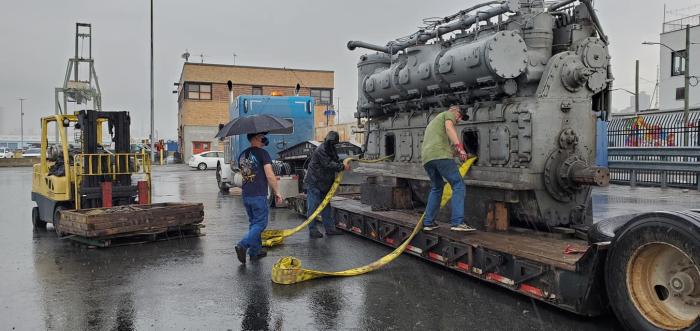 In May of this year, we posted Scrambling to Save an Engine for the Historic Tanker Mary A. Whalen. The post described how the historic tanker Mary A. Whalen was in dire need of parts to restore its diesel engine. A powerplant in Missouri had a compatible diesel. All that was necessary was to raise the money to move the engine cross-country before the power plant needed to dispose of the engine.
In May of this year, we posted Scrambling to Save an Engine for the Historic Tanker Mary A. Whalen. The post described how the historic tanker Mary A. Whalen was in dire need of parts to restore its diesel engine. A powerplant in Missouri had a compatible diesel. All that was necessary was to raise the money to move the engine cross-country before the power plant needed to dispose of the engine.
Thanks to the support of generous donors and despite the deadly pandemic, enough was raised to rescue the engine and truck it to Brooklyn. The new/old engine will be key to restoring the Mary A. Whalen‘s Fairbanks Morse 37E12, six-cylinder, direct reversing engine. Congratulations to Portside New York and thanks to all those who helped make it happen.
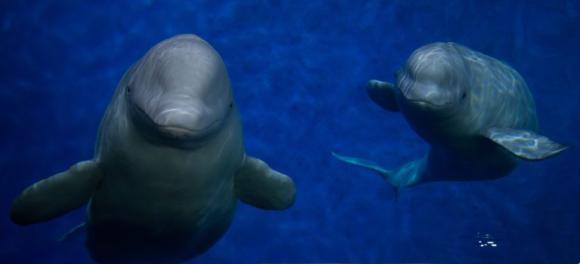 Earlier this year, we posted “The Incredible Journey of Belugas Little White and Little Grey,” about the 6,000-mile transport in June 2019 of the two whales by air, land, and sea from an aquarium in Shanghai to a new home in Iceland in the world’s first beluga whale sanctuary.
Earlier this year, we posted “The Incredible Journey of Belugas Little White and Little Grey,” about the 6,000-mile transport in June 2019 of the two whales by air, land, and sea from an aquarium in Shanghai to a new home in Iceland in the world’s first beluga whale sanctuary.
After just over a year in Iceland, the two belugas have now moved closer to the open water sanctuary. From the sanctuary press release:
The SEA LIFE Trust is delighted to confirm that two beluga whales, Little Grey and Little White, are now safely in their new sea sanctuary care area at Klettsvik Bay in Iceland. The moving of the whales into the world’s first open water sanctuary for belugas was completed on Friday 8th August 2020 at 12.30 local time. Continue reading
Comment/Replies to Posts are now back. We have also shifted to a much more mobile-friendly format, which is to say that the blog should be easier to read from a phone or tablet. There is still some tweaking and updating going on, but we are getting there.
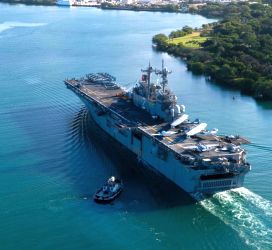 USS Essex, a Wasp-class amphibious assault ship, recently arrived in Hawaii’s Pearl Harbor. Rather than carrying just helicopters, MV-22 Osprey tiltrotors, or even F-35B Lightning II fighter jets, the ship had a deck load of historic World War II warplanes. The planes are set to take part in a commemoration of the 75th anniversary of the end of WWII from August 29 to September 2.
USS Essex, a Wasp-class amphibious assault ship, recently arrived in Hawaii’s Pearl Harbor. Rather than carrying just helicopters, MV-22 Osprey tiltrotors, or even F-35B Lightning II fighter jets, the ship had a deck load of historic World War II warplanes. The planes are set to take part in a commemoration of the 75th anniversary of the end of WWII from August 29 to September 2.
The Essex carried a B-25 bomber, two PBY Catalina flying boats, an SNJ/AT-6 Texan, four AT-6 Texans, an FM2 Wildcat, F8F Bearcat, Stearman biplane, TBM Avenger, P-51 Mustang and a T-28 Trojan.
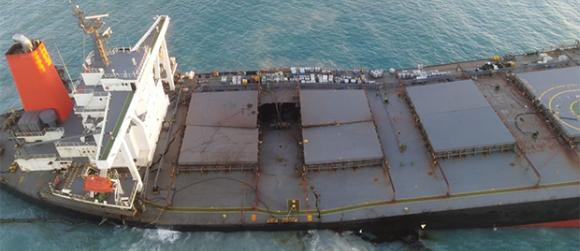 How does a modern ship with radar and GPS manage to run hard aground on a well-marked reef? In the case of the Capesize bulker Wakashio that ran aground on the reef at Pointe-d’Esny off Mauritius on the evening of July 25, the answer appears to be a birthday party and an attempt to pick up a wifi signal.
How does a modern ship with radar and GPS manage to run hard aground on a well-marked reef? In the case of the Capesize bulker Wakashio that ran aground on the reef at Pointe-d’Esny off Mauritius on the evening of July 25, the answer appears to be a birthday party and an attempt to pick up a wifi signal.
L’Express.mu reports that investigators from Mauritius have learned from interviews with the ship’s crew that just before the grounding there was a birthday party for one of the ship’s crew. Also, the ship’s course was changed to bring it closer to the island in an attempt to pick up a wifi signal.
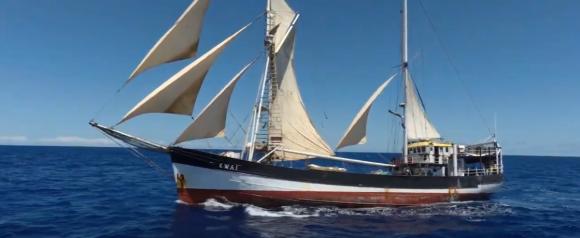 In June of last year, we posted about the sailing cargo ship Kwai that had collected more than 40 tons of plastic waste and “ghost nets” from the Pacific Garbage Patch. Ghost nets are abandoned fishing gear that continues to drift, catching and killing thousands of marine animals.
In June of last year, we posted about the sailing cargo ship Kwai that had collected more than 40 tons of plastic waste and “ghost nets” from the Pacific Garbage Patch. Ghost nets are abandoned fishing gear that continues to drift, catching and killing thousands of marine animals.
The Kwai, backed by the non-profit Ocean Voyages Institute, is setting new records for ocean cleanup. During a voyage in June, the ship retrieved 103 tons of plastic waste. Most recently, in a voyage ending in early August, the Kwai added 67 tons, for a total of 170 tons of plastic waste and nets removed from the Pacific. The haul quadruples the group’s previous year’s record. The Kwai’s endeavors are believed to represent the largest open ocean clean-up in history. Overall, the Ocean Voyages Institute is committed to removing 1 million pounds of plastic from the ocean.
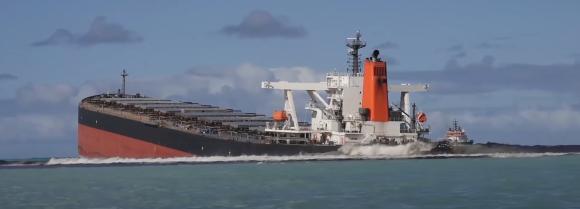
On July 25, the MV Wakashio ran hard aground on a coral reef in Mauritius. The large capesize bulker was bound From China to Brazil to load cargo and was empty, operating in ballast when it struck the reef. On August 6, after 13 days aground, the ship began to leak fuel oil. Over 1,000 tonnes of 4,000 tonnes aboard leaked into the pristine waters. The grounding took place off of Pointe d’Esny, near the marine park of Blue Bay. Mauritius is home to world-renowned coral reefs, and tourism is a crucial part of its economy.
Mitsui OSK, the ship operator, supported by a French pollution-control team and the Mauritius Coast Guard, has been working to pump out the remaining fuel oil before the ship breaks up. Today, the Mauritius Prime Minister Pravind Jugnauth announced that almost all the fuel oil remaining aboard the ship has been pumped out.
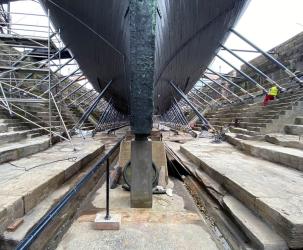
View from Astern, June 2020
When HMS Victory went into drydock in the Portsmouth Historic Dockyard in 1922, she was supported by 22 steel cradles. In the almost 100 years that she has remained on the dock, the historic ship’s 3,500-tonne hull had been to slowly collapse in on itself. To save the ship, the cradles have been replaced by an innovative system of 134 “props” that replicate the loads HMS Victory would have encountered while afloat. The ship will now be, at least figurately, floating in the drydock.
The new props, a collaboration between the National Museum of the Royal Navy and BAE Systems, are more than a series of struts to support the hull. Each prop contains sensors and hydraulics to monitor the load on the ship’s hull and adjust the weight being carried by each strut to most effectively support the 255-year-old wooden structure.
 Having grown up on the Gulf Coast of Florida, I can say without hesitation that a hurricane is the most magnificent and absolutely the most terrifying of all events in nature. Recently NOAA announced that their Atlantic forecast is for an “extremely active” 2020 hurricane season, with 19-25 named storms and 3-6 major hurricanes. So, Eric Jay Dolin’s new book, A Furious Sky, the Five-Hundred-Year History of America’s Hurricanes is indeed most timely.
Having grown up on the Gulf Coast of Florida, I can say without hesitation that a hurricane is the most magnificent and absolutely the most terrifying of all events in nature. Recently NOAA announced that their Atlantic forecast is for an “extremely active” 2020 hurricane season, with 19-25 named storms and 3-6 major hurricanes. So, Eric Jay Dolin’s new book, A Furious Sky, the Five-Hundred-Year History of America’s Hurricanes is indeed most timely.
Dolin’s history of American hurricanes begins with Columbus’ fourth and last voyage to the Americas. Like other Europeans, Columbus arrived in the “New World” without even knowing the word hurricane.
On his previous voyages, Columbus had encountered severe storms and had heard of far worse meteorological monsters from the indigenous Taino natives. They called the giant storms juracan. The Taino also taught Columbus how to read the signs of an impending juracan.
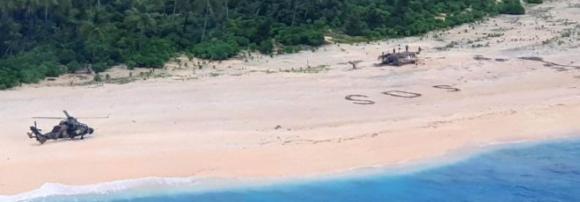 A recent news item brought to Gilligan’s Island, a situation comedy broadcast on US television for three seasons in the 1960s. The premise of the program was that a small tourist boat on a “three-hour tour” was swept away in a storm to an “uncharted desert isle.” Fortunately for all concerned, the sailors involved were stranded on an uninhabited island for only three days because they marked the beach with a large “SOS” to assist rescuers.
A recent news item brought to Gilligan’s Island, a situation comedy broadcast on US television for three seasons in the 1960s. The premise of the program was that a small tourist boat on a “three-hour tour” was swept away in a storm to an “uncharted desert isle.” Fortunately for all concerned, the sailors involved were stranded on an uninhabited island for only three days because they marked the beach with a large “SOS” to assist rescuers.
USS Ling is a US Navy Balao-class submarine. The sub is currently sitting in the mud in the Hackensack River at the former location of the defunct New Jersey Naval Museum in Hackensack, New Jersey. The Ling has no access from shore, has been flooded, and vandalized. Marine enthusiasts are interested in restoring the ship but have not found answers to the logistical challenges of moving the submarine out of a silted up river and past four bridges across the Hackensack River, south of the Ling, that do not open or move.
Here is a video tour of the submarine posted last week.

Sandy Hook Pilot Captain Timothy M. Murray
Sandy Hook ship pilot, Captain Timothy M. Murray died following a fall while boarding a tanker arriving at the Port of New York and New Jersey on Wednesday. His death is the second pilot fatality in less than a year. Both incidents took place while boarding. In December 2019, Captain Dennis Sherwood was killed in a fall while boarding an inbound containership arriving in the harbor.
Captain Murray’s recent death has renewed the focus on the arrangement of the boarding ladders and platforms on many merchant ships, specifically the “trapdoor” pilot ladder arrangement. While common, the trapdoor arrangement does not meet IMO standards. The pilot ladder arrangement requires the pilot to pull themselves up while also twisting to ensure proper footing on the platform.
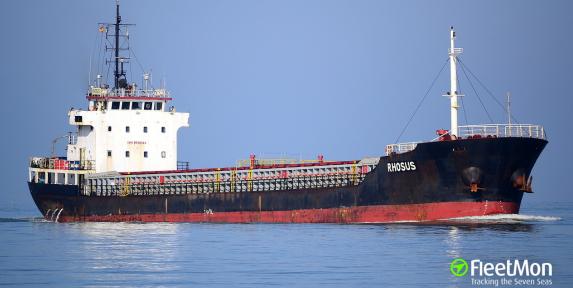 The events leading up to the catastrophic explosion in Beirut, Lebanon that killed more than 135 and injured 5,000, began in November 2013, when the cargo ship MV Rhosus, loaded with 2,750 tonnes of ammonium nitrate, made an unplanned stop in Beirut.
The events leading up to the catastrophic explosion in Beirut, Lebanon that killed more than 135 and injured 5,000, began in November 2013, when the cargo ship MV Rhosus, loaded with 2,750 tonnes of ammonium nitrate, made an unplanned stop in Beirut.
The ship, built in 1986, flying the flag of Moldova, was carrying the cargo to an explosives manufacturing firm in Mozambique. Reportedly, the ship’s owner, a Russian living in Cyprus, lacked the funds to pay the Suez Canal fees, so the ship was diverted to Beirut to pick up a cargo of heavy machinery to earn the additional cash needed to complete the journey. Once in Beirut, the machinery couldn’t be loaded and local authorities cited the ship as unseaworthy. The ship would not be allowed to leave the port until repairs were made.

Port of Beirut Explosion Aftermath
Yesterday, a massive explosion in the port of Beirut, Lebanon killed at least 100 people and injured thousands. The blast destroyed buildings in the port district while the shockwave shattered windows and overturned vehicles across the city. An estimated 300,000 people have been displaced from their homes. With an untold number of people still missing, officials expect that the death toll will rise.
The force of the explosion was the equivalent to a magnitude 3.5 earthquake and could be heard and felt as far away as Cyprus, about 200 kilometers across the Mediterranean.
While the cause of the explosion is still being investigated, it is believed to have been caused by the ignition of about 2,750 tonnes of ammonium nitrate that had been stored in a warehouse at the port since it was confiscated from a cargo ship in 2014. The chemical is used for fertilizer and as an explosive.
 Alexander Hamilton suggested in The Federalist Papers that “a few armed vessels, judiciously stationed at the entrances of our ports, might at a small expense be made useful sentinels of the laws.”
Alexander Hamilton suggested in The Federalist Papers that “a few armed vessels, judiciously stationed at the entrances of our ports, might at a small expense be made useful sentinels of the laws.”
When Hamilton became the first Treasury Secretary of the newly formed United States, he lobbied for the acquisition of 10 revenue cutters to assist in the collection of duties and to catch smugglers. On August 4, 1790, 230 years ago today, President Washington signed a bill establishing the Revenue Cutter Service, the precursor to today’s United States Coast Guard. Alexander Hamilton is considered by many to be the father of the US Coast Guard.
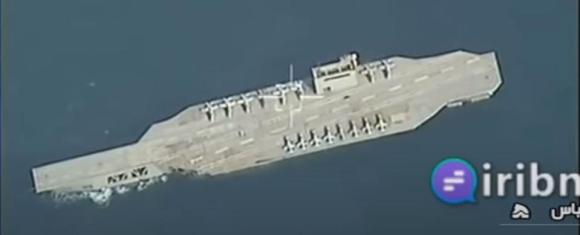
Iranian “aircraft carrier” before capsizing
This seems like a good story for a Monday. Forbes reports that Iran accidentally sank its fake aircraft carrier and did so in a very inconvenient place. The “fake carrier” is actually a targeting barge, a scaled-down mockup of a U.S. Navy Nimitz-class aircraft carrier, that Iran’s armed forces has been using for training and war games. The fake carrier, built in 2014, was intended to be reusable and has been symbolically ‘destroyed’ at least twice already in exercises.
After the most recent attacks on the carrier, however, something went wrong. While being towed back to Bandar Abbas, the craft developed a serious list and then capsized.
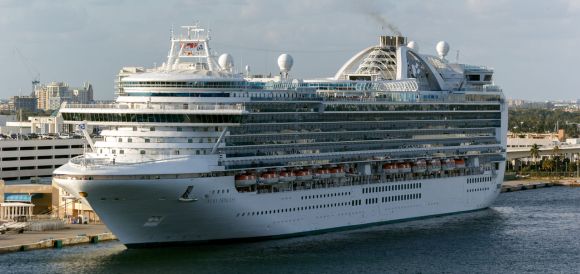 On March 19, 2020, the Princess Cruise Line ship Ruby Princess arrived in Sydney, New South Wales, Australia, and disembarked 2,700 passengers. These passengers included those who had been isolated in their cabins with fever. Roughly 2,000 of the passengers had been swabbed for coronavirus but were allowed to leave before the test results were available.
On March 19, 2020, the Princess Cruise Line ship Ruby Princess arrived in Sydney, New South Wales, Australia, and disembarked 2,700 passengers. These passengers included those who had been isolated in their cabins with fever. Roughly 2,000 of the passengers had been swabbed for coronavirus but were allowed to leave before the test results were available.
Within two months, COVID-19 infections associated with passengers from Ruby Princess became the largest coronavirus cluster outside of Wuhan, China, with at least 662 cases of the virus and 22 known deaths. Additional cases may have been spread internationally by 900 passengers from countries other than Australia who left Sydney after the ship docked.
Why were so many passengers allowed to disembark without test results? It now appears that a senior Australian Border Force (ABF) officer confused the results for flu tests with those for the coronavirus. He mistakenly believed passengers displaying “flu-like symptoms” had tested negative to COVID-19, when they had instead only tested negative for the common flu.
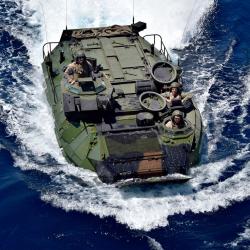
Photo:Mass Communication Specialist 1st Class Daniel Barker/Navy
One Marine died and two were critically injured on Thursday off the coast of California when an amphibious assault vehicle (AAV) from the 15th Marine Expeditionary Unit took on water and sank rapidly. Seven Marines and one Navy sailor are missing and feared dead.
Marine Corps Times reports that the AAV was returning to the amphibious transport dock USS Somerset after conducting a training raid at San Clemente Island, California. The vehicle had 15 Marines and one sailor aboard at the time, according to the document and later confirmed by the Marine Corps.
